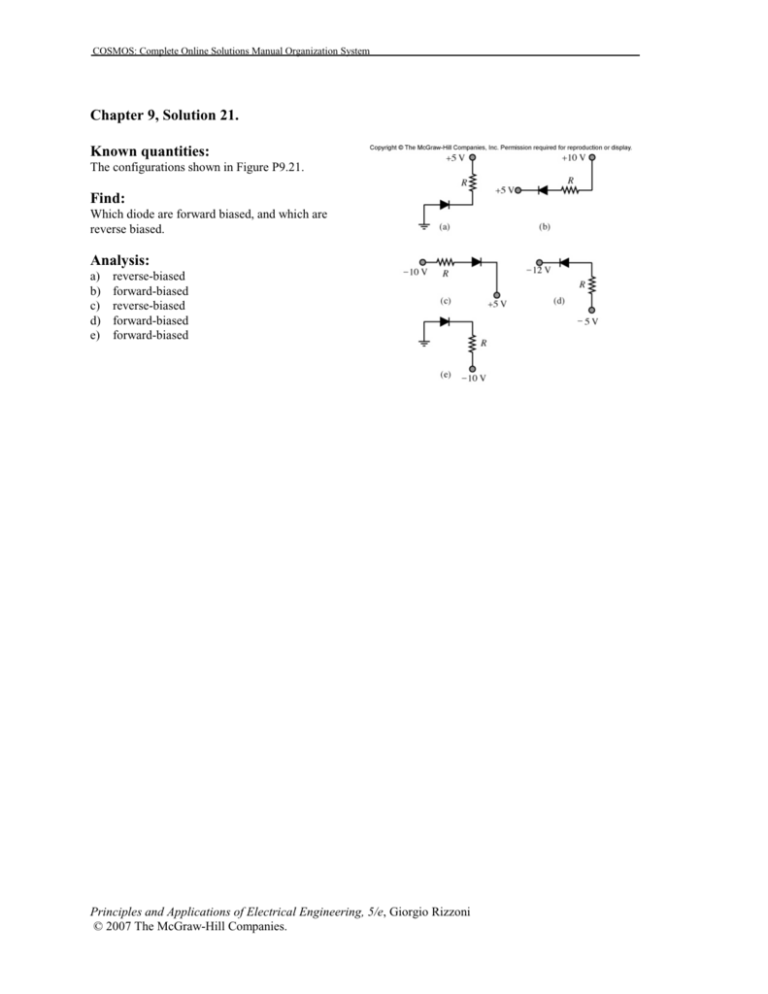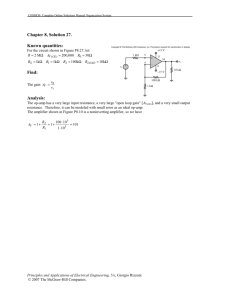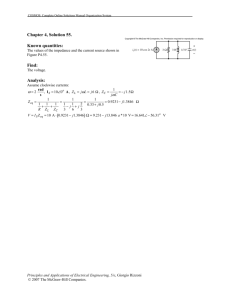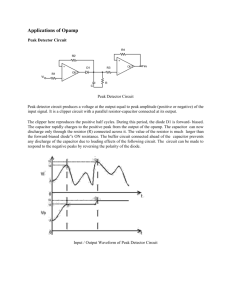Chapter 9, Solution 21. Known quantities: Find: Analysis:
advertisement

COSMOS: Complete Online Solutions Manual Organization System Chapter 9, Solution 21. Known quantities: The configurations shown in Figure P9.21. Find: Which diode are forward biased, and which are reverse biased. Analysis: a) b) c) d) e) reverse-biased forward-biased reverse-biased forward-biased forward-biased Principles and Applications of Electrical Engineering, 5/e, Giorgio Rizzoni © 2007 The McGraw-Hill Companies. COSMOS: Complete Online Solutions Manual Organization System Chapter 9, Solution 9. Known quantities: The circuit of figure of P9.9. Find: Determine whether the diode is conducting or not. Analysis: The Thèvenin equivalent resistance on the left is RT = 2.5Ω . The Thèvenin equivalent voltage is: ⎛ V + VC ⎞ VT = ⎜ i ⎟ × 5 − VC = 3.5V ⎝ 10 ⎠ Assuming the diode is conducting, I= 3.5 − 10 = −2.6 A 2.5 This contradicts the assumption. Thus the diode is off. Principles and Applications of Electrical Engineering, 5/e, Giorgio Rizzoni © 2007 The McGraw-Hill Companies. COSMOS: Complete Online Solutions Manual Organization System Chapter 9, Solution 13. Known quantities: The circuit of figure of P9.13. Find: Sketch iD (t ) . Analysis: (a) The diode current iD (t ) , is i D = 100 mA for t < 10 ms i D = 0 mA for 10 < t < 20 ms i D = 100 mA for 20 < t < 30 ms iD (mA) 100 0 10 20 30 t (ms) 10 20 30 t (ms) (b) The diode current iD (t ) , is 10 − 0.6 = 94 mA for t < 10 ms 100 i D = 0 mA for 10 < t < 20 ms i D = 94 mA for 20 < t < 30 ms iD = iD (mA) 94 0 Principles and Applications of Electrical Engineering, 5/e, Giorgio Rizzoni © 2007 The McGraw-Hill Companies. COSMOS: Complete Online Solutions Manual Organization System Chapter 9, Solution 14. Known quantities: The circuit of figure of P9.14. Find: The range of Vin for a forward-biased D1 . Analysis: Assume diode D1 is conducting; the diode current is I= Vin − 2 ≥0 1500 Since the current is positive, the initial assumption was correct. Therefore, the range of Vin is: Vin ≥ 2V . Principles and Applications of Electrical Engineering, 5/e, Giorgio Rizzoni © 2007 The McGraw-Hill Companies. COSMOS: Complete Online Solutions Manual Organization System Chapter 9, Solution 20. Known quantities: The circuit of Figure P9.20 driven by a sinusoidal source of 50 V rms , Vγ = 0.7 V, R = 220 Ω. Find: a) The maximum forward current. b) The peak inverse voltage across the diode. Analysis: 50 2 − 0.7 = 318 mA 220 a) I Fmax = b) Vrevmax = 50 2 = 70.7 V Principles and Applications of Electrical Engineering, 5/e, Giorgio Rizzoni © 2007 The McGraw-Hill Companies. COSMOS: Complete Online Solutions Manual Organization System Chapter 9, Solution 62. Find: Develop a series diode clipper circuit to separate a signal as shown in Figure P9.62. Analysis: Principles and Applications of Electrical Engineering, 5/e, Giorgio Rizzoni © 2007 The McGraw-Hill Companies. COSMOS: Complete Online Solutions Manual Organization System Chapter 9, Solution 24. Known quantities: The circuit of Figure P9.24; vS (t ) = 10 sin (2,000πt ) . Find: The output waveform and the voltage transfer characteristic. Assumptions: The diode is ideal. Analysis: For vS <8 V, vo=4 V. For vS ≥ 8 V, vo= vS /2. The voltage transfer characteristic is vo 5 4 8 0 vo (V) 8 16 vS 0 0.5 Principles and Applications of Electrical Engineering, 5/e, Giorgio Rizzoni © 2007 The McGraw-Hill Companies. 1 1.5 2 t (ms) COSMOS: Complete Online Solutions Manual Organization System Chapter 9, Solution 64. Known quantities: The input voltage waveform and the circuit of Figure P9.64. Find: Determine the output voltage. Analysis: For vin < 50.7 V , vout = vin . When vin ≥ 50.7 V , vout = 50.7 + ( ) 0.6 vin = 50.7 + 6.085 × 10−3 vin 98 + 0.6 The input and output voltage waveforms are sketched below: Principles and Applications of Electrical Engineering, 5/e, Giorgio Rizzoni © 2007 The McGraw-Hill Companies. COSMOS: Complete Online Solutions Manual Organization System Chapter 9, Solution 33. Known quantities: The circuit of Figure P9.33. The input voltage is sinusoidal with an amplitude of 5 V. Find: The average value of the output voltage. Assumptions: Vγ = 0.7 V . Analysis: The capacitor will charge to 5 V − 0.7 V = 4.3 V and, therefore, the input sine wave will be shifted up 4.3 V to produce the output. As a result, after the cycle (the capacitor builds up its stored charge during the third quarter cycle), the average value of the output will be 4.3 V. Principles and Applications of Electrical Engineering, 5/e, Giorgio Rizzoni © 2007 The McGraw-Hill Companies. COSMOS: Complete Online Solutions Manual Organization System Chapter 9, Solution 29. Known quantities: A diode with the i-v characteristic in Figure 9.8 in the text, connected to a 5 V source and a load resistance of 200 Ω. Find: a) The load current and voltage b) The power dissipated by the diode. c) The load current and voltage if the load is changed to 100 Ω and 500 Ω. Analysis: a) The operating point can be determined by using the load-line analysis Diode i−v curve The load line is v 5 − vD 5 iD = = − D RL 200 200 vL = 5 − vD ≅ 5 − 0.74 = 4.26 V The load current is obtained by the figure as intersection of the two characteristics and is equal to 0.021 A. 0.045 0.04 0.035 Diode current, A The load voltage is 0.05 0.03 0.025 0.02 0.015 0.01 0.005 b) The power dissipated by the diode is 0 0 0.2 0.4 0.6 Diode voltage, V PD = vD iD = 0.74 ⋅ 0.021 = 15 mV 0.8 1 Diode i−v curve c) 0.05 For RL=100 Ω, we have 0.045 vD ≅ 0.757 V 5 − 0.757 = 0.0424 A 100 vL = 5 − 0.757 = 4.24 V 0.04 iD = iL = 0.035 Diode current, A Similarly, for RL = 500 Ω, we have 0.03 0.025 0.02 0.015 vD ≅ 0.717 V 5 − 0.717 iD = iL = = 0.04283 A 100 vL = 5 − 0.717 = 4.283 V RL=100 Ω R =500 Ω L 0.01 0.005 0 0 0.2 Principles and Applications of Electrical Engineering, 5/e, Giorgio Rizzoni © 2007 The McGraw-Hill Companies. 0.4 0.6 Diode voltage, V 0.8 1 COSMOS: Complete Online Solutions Manual Organization System Chapter 9, Solution 50. Known quantities: Figure P9.50. The output voltage at 5.6 V. Find: Determine the minimum value of RL for which the output voltage remains at just 5.6 V. Analysis: RLmin RL min +1800 (18) = 5.6 ⇒ 12.4RL min = 10080 ⇒ RL min = 812.9 Ω Principles and Applications of Electrical Engineering, 5/e, Giorgio Rizzoni © 2007 The McGraw-Hill Companies. COSMOS: Complete Online Solutions Manual Organization System Chapter 9, Solution 59. Known quantities: The circuit of Figure P9.59; the desired load voltage is 14V; The Zener diode is rated at 14V, 5W. Find: The range of load resistance for regulation. Analysis: VS = 50 V , Zener is rated VZ = 14 V, 5 W The minimum load resistance can be calculated by assuming that all the source current goes to the load, and that the load voltage is regulated at the nominal value: V VZ 14 = = 11.7 Ω R Lmin = Z = (VS − VZ ) 30 36 / 30 iS The maximum current through the Zener diode that does not exceed the diode power rating is P 5 = 0.357 A i Z max = Z = VZ 14 The source current is V − VZ 50 − 14 iS = S = = 1 .2 A 30 30 So the maximum load resistance is VZ 14 = = 16.6 Ω R Lmax = i S max − i Z max 0.843 Thus, the range of allowable load resistance: 11.7 Ω ≤ R L < 16.6 Ω Principles and Applications of Electrical Engineering, 5/e, Giorgio Rizzoni © 2007 The McGraw-Hill Companies.











